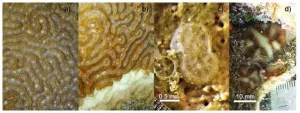(Press-News.org) The neurons in our bodies are dotted with tiny pores that let essential molecules pass in and out of our cells. Neurons need these channels to send the signals that allow us to move, think, and perceive the world around us. Now, structural biologists at Cold Spring Harbor Laboratory (CSHL) have captured never-before-seen images of one of the largest pores in human neurons. It’s called calcium homeostasis modulator protein 1, or CALHM1 for short.
Previous studies have shown that mutations in the Cahlm1 gene may be a risk factor for Alzheimer’s disease. CSHL’s new research reveals, for the first time, how the channel works in humans and how it can get jammed up.
CSHL Professor Hiro Furukawa and postdoc Johanna Syrjänen have been studying CALHM1 for several years. It seems to be involved in a vast array of physiological processes. In our tongues, CALHM1 detects tastes like sweet, sour, or umami. In our brains, CALHM1 may play a role in controlling the buildup of a plaque-forming protein associated with Alzheimer’s.
Furukawa, Syrjänen, and colleagues used a method called cryo-electron microscopy to generate detailed, three-dimensional images of the human CALHM1 channel. The images show how eight copies of the CALHM1 protein assemble together to form the circular channel. Each protein has a flexible arm that reaches into the pore, possibly controlling how it opens and closes. Syrjänen likens the arms to “octopus tentacles.”
The team also discovered that fatty molecules called phospholipids are critical for stabilizing and regulating the eight-part channel. Eggs, cereal, lean meats, and seafood all contain loads of these important fats. Additionally, Furukawa’s lab showed how a chemical that researchers use to block CALHM1 becomes lodged in the channel. That knowledge could be useful if someday researchers aim to develop a drug that targets CALHM1. Syrjänen says:
“If you are thinking way down the line, ‘Can we control taste perception or influence this protein?’ we now know one of the places where you could block the protein activity.”
Syrjänen notes that the human CALHM1 channel looks a lot like the version she and Furukawa studied in chickens in 2020. Determining the structure of the human protein proved more technically challenging. But, researchers agree, it’s vital for learning about the channel’s role in human health.
“There are numerous unanswered questions surrounding CALHM1,” Furukawa says. For example, how does the energy-carrying molecule, ATP, escape from cells via this channel? And could this trigger the body’s inflammatory response? “Our research group will continue unraveling this vital molecular machine to better understand the CALHM1 channel’s functionality.”
END
This eight-armed octopus-like pore detects taste
2023-07-14
ELSE PRESS RELEASES FROM THIS DATE:
New study demonstrates the potential of diseased coral parents in restoring stony coral tissue loss disease-affected species
2023-07-14
Stony Coral Tissue Loss Disease (SCTLD) has wreaked havoc on coral reefs across the Caribbean, resulting in significant mortality of various coral species, including Pseudodiploria strigosa, which has been particularly affected in the Mexican Caribbean. In response to the decreased abundance and colony density caused by SCTLD, scientists have explored larval-based restoration methods, despite concerns about disease transmission. A new PeerJ Life & Environment study reveals that even colonies affected by SCTLD can play a vital role in the assisted sexual reproduction for the restoration of SCTLD-susceptible species.
The ...
Owning a pet does not reduce symptoms of severe mental illness, study shows
2023-07-14
Living with and having a close bond with a companion animal does not necessarily lead to significant mental health improvements in people with a serious mental illness, say researchers.
A survey, conducted by the University of York, revealed that living with an animal - a dog, cat, fish or bird for example - did not improve wellbeing or reduce depression, anxiety or feelings of loneliness for owners with serious mental illness, such as bipolar disorder or schizophrenia, compared to those who live without an animal.
The researchers, who followed up on an earlier survey conducted in 2021 on investigating aspects of animal ownership and mental ...
AI brings hope for patients with lyosomal storage disease
2023-07-14
Artificial intelligence is becoming increasingly important in drug discovery. Advances in the use of Big Data, learning algorithms and powerful computers have now enabled researchers at the University of Zurich (UZH) to better understand a serious metabolic disease.
Cystinosis is a rare lyosomal storage disorder affecting around 1 in 100,000 to 200,000 newborns worldwide. Nephropathic (non-inflammatory) cystinosis, the most common and severe form of the disease, manifests with kidney disease symptoms ...
Pets do not significantly benefit the emotional health of owners with severe mental illness, study shows
2023-07-14
A new study published in the CABI journal Human-Animal Interactions suggests that companion animals – including dogs, cats, fish and birds – do not significantly benefit the emotional health of owners with severe mental illness.
Results showed that owning an animal was not significantly associated with the wellbeing, depression, anxiety or loneliness scores for owners with a range of severe mental illnesses such as bipolar disorder or psychosis.
The researchers, who followed up on an earlier survey conducted ...
Scientists knit futuristic eco-building designs using fungal networks
2023-07-14
Scientists hoping to reduce the environmental impact of the construction industry have developed a way to grow building materials using knitted molds and the root network of fungi. Although researchers have experimented with similar composites before, the shape and growth constraints of the organic material have made it hard to develop diverse applications that fulfil its potential. Using the knitted molds as a flexible framework or ‘formwork’, the scientists created a composite called ‘mycocrete’ which is ...
Ketamine effective for treatment-resistant depression: clinical trial
2023-07-14
A low-cost version of ketamine to treat severe depression has performed strongly in a double-blind trial that compared it with placebo.
In research published today in the British Journal of Psychiatry, researchers led by UNSW Sydney and the affiliated Black Dog Institute found that more than one in five participants achieved total remission from their symptoms after a month of bi-weekly injections, while a third had their symptoms improve by at least 50 per cent. The study was a collaboration between ...
Welcome, Big Tuna! New commanding officer takes command at the Office of Naval Research Global
2023-07-14
The Office of Naval Research (ONR) Global, ONR’s international arm, welcomed new leadership today, as Capt. Andy “Big Tuna” Berner was sworn in as the new ONR Global commanding officer during a ceremony at Naval Air Station Patuxent River, Maryland. Berner takes over for Capt. Matthew Farr.
Chief of Naval Research Rear Adm. Kurt Rothenhaus served as presiding officer of the change-of-command ceremony, as well as presenter of awards.
“Learning from our partners and allies ...
Delayed RSV prophylactic during atypical RSV surges and RSV hospitalization spikes in high-risk kids
2023-07-14
As a result of the COVID-19 pandemic, respiratory syncytial virus (RSV) surges in young children occurred outside the usual November to March season, when immune-based prophylactic is available to protect children at high risk for severe illness. In 2021, RSV season began in May, leaving these kids without a prophylactic until September, due to lack of drug availability and challenges with insurance authorization for off-season administration. During this time, pediatric hospitalizations for RSV in 2021-2022 spiked and ...
THE LANCET HEALTHY LONGEVITY: Razor-sharp memory function in older adults linked to faster movement and better mental health, study suggests
2023-07-14
Peer-reviewed / Observational study / People
One of the largest observational studies to date of ‘superagers’ – people in their eighties with the memory function of people decades younger – suggests they also move more quickly and have better mental health than typical older adults.
MRI scans add to evidence that superagers have more grey matter in key regions linked to memory function.
No differences in biomarkers or genetic risk factors for neurodegenerative disease were detected between superagers and typical older adults, suggesting ...
App helps identify autistic children in India – study
2023-07-14
Children with autism and related neurodevelopmental disorders in India can be successfully identified by community healthcare workers using a low-cost app, a study has found.
The results, published today (Friday 14 July) in Autism, could open the door to help millions of children with autism spectrum conditions to get earlier screening quickly and inexpensively, leading to life-changing support.
Researchers from India, the UK and US tested the app with 131 two- to seven-year-olds living in low-resource neighbourhoods of Delhi, India.
The tests were carried out at the homes of the children, by non-specialist ...




